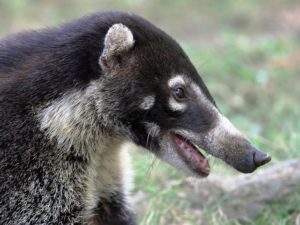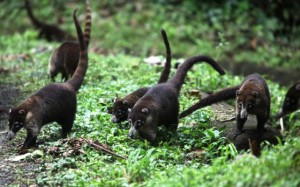Meet the Curious Coatimundi
Most Costa Rica vacations promise spectacular wildlife encounters – perhaps none more exciting than the nation’s highly acrobatic primate species. When not marveling over the throaty roars of howler monkeys or amusing antics of capuchins, you may find yourself entranced with the wonderfully curious coatimundi (or coati for short). Locally, they’re known as pizotes – a raccoon-like creature with a long snout, pointy tail and endearing personality. The white-nosed coati is one of the country’s most prolific mammals, and is often seen in tourist hotspots like Arenal, Manuel Antonio, Monteverde, Puerto Viejo and Dominical.
Click here and make your visit to Costa Rica special by booking a stay at our amazing villas!

Pizotes at a glance
A large male coati can tip the scales at nearly 18 pounds, and with his dark, brownish-red fur and nocturnal preferences, it is often mistaken for a large feline. Make no mistake, these resourceful creatures belong to the same family as raccoons, and are known for their ability to adapt to just about any habitat or terrain. They will feast on crocodile and bird eggs, crabs, shellfish, fruits, leaves, nuts, lizards, invertebrates, birds, and carrion as well. Often seen in bands of 20 members, coatis are skilled climbers and, with the aid of their agile prehensile tails, can amble up the tallest of trees in search of food or safety.
Coati behavior and mating habits
Visitors to Manuel Antonio National Park are nearly guaranteed at least one coati sighting – typically beneath the rainforest canopy where adults can be seen nosing around for food. If you spot a solitary pizote, it is most definitely a male, who communicates through snorting, twittering and grunting sounds in an effort to define territory. The males seek out the company of others only for mating, and otherwise spend their days solo. Females generally make their nests in the safety of trees and give birth to a litter of 4-7 young. In Costa Rica, pizote breeding season normally coincides with the start of the rainy season, to ensure all clan members have access to abundant food.

Costa Rica pizote sightings
Luckily, other than habitat loss, the coati faces few challenges in its survival in Central America. Since they adapt so well and eat a wide variety of foods, white-nosed coati populations are thriving in Costa Rica, where large clans are often witnessed in and around protected areas. While it may seem tempting to offer one food, please think twice before doing so as this encourages a dependency on humans and may incite some aggressive behavior. Playful, inquisitive and often mischievous, coatis are very similar to their raccoon cousins in their insatiable appetite to explore the unknown.
Look for them in the following National Park destinations:
- Cahuita National Park
- Manuel Antonio National Park
- Carara National Park
- Monteverde Cloud Forest Reserve
- Arenal Volcano National Park

 +1 888-818-2097
+1 888-818-2097
 +506 8932-4731
+506 8932-4731